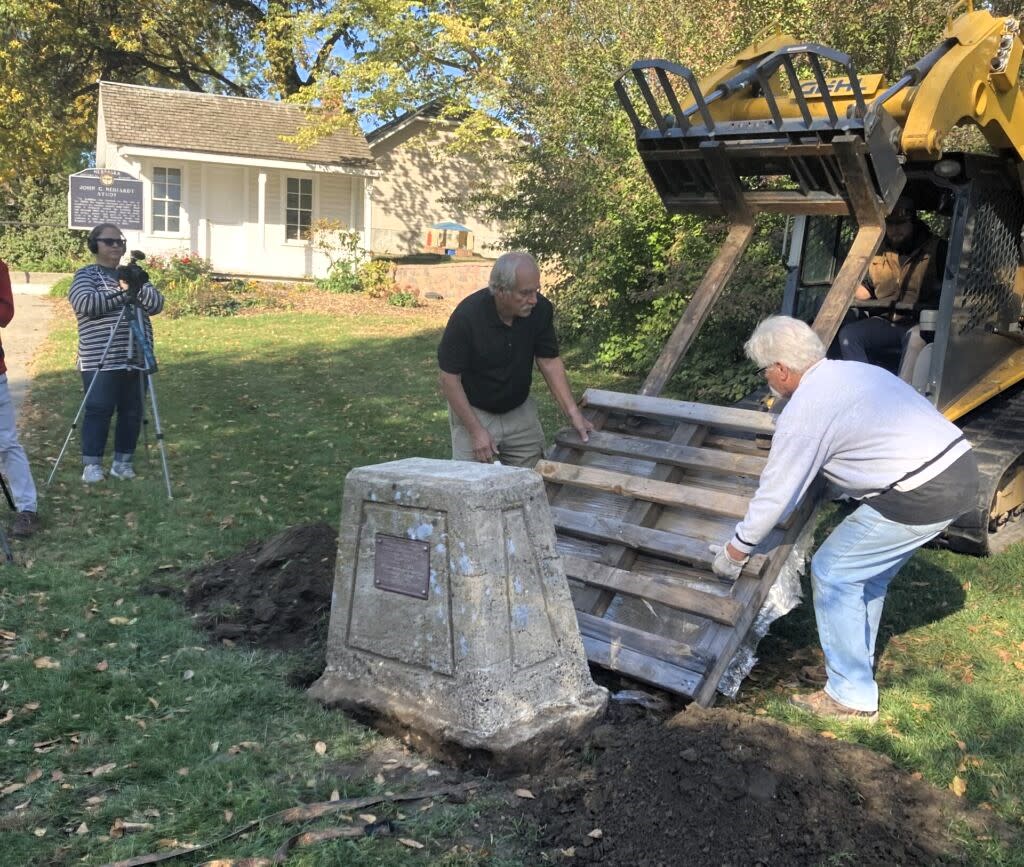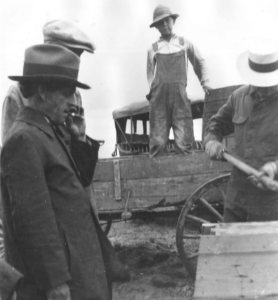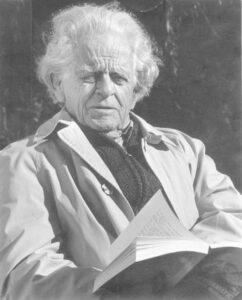Reveal planned of contents found in South Dakota monument

- Oops!Something went wrong.Please try again later.
The descendants of poet/author John Neihardt work to ease a 3,200-pound monument into place in October 2023 at the Nebraska state historic site dedicated to Neihardt. The study in the background is where Neihardt wrote “The Song of Hugh Glass,” the subject of the monument. (Paul Hammel/Nebraska Examiner)
LINCOLN, Nebraska — We’ll soon know whether some documents buried inside a concrete monument erected by poet/author John Neihardt 100 years ago survived three floods and decades of harsh winters on the plains of northwest South Dakota.
On April 27, the contents of a time capsule embedded inside the monument will be revealed as part of the annual spring conference of the John Neihardt Foundation at Wayne State College in Nebraska.
1½-ton monument moved to Nebraska
The conference will focus on the 1923 construction of the homemade monument that honors the heroism of mountain man Hugh Glass, as well as the twists and turns that led to moving the 1½-ton concrete marker from near Lemmon, South Dakota, to the Neihardt State Historic Site in Bancroft, Nebraska.
Members of the Neihardt family, who retrieved the monument in October, aren’t discounting the possibility that Mother Nature might have gotten the best of what was inside the time capsule. The poet/author, the poet laureate in perpetuity of Nebraska, said he left an “original manuscript” inside as well as other documents.
Coralie Hughes, a granddaughter of Neihardt, was mum during a recent email exchange about whether a valuable literary work was found inside, or whether — like the live TV opening of gangster Al Capone’s vault in 1986 — nothing of value was found.
Story will be ‘revealed’
“The story of Hugh Glass and Neihardt’s Hugh Glass monument move to Nebraska will be revealed in its entirety,” said Hughes in an email.
The monument was erected on private land in the area where Glass was reportedly mauled by a grizzly bear in 1823. Later, it had to be moved to accommodate the construction of the federal Shadehill Reservoir.
Author/poet John Neihardt, left, supervises the final construction of a concrete monument erected in 1923 to commemorate the heroics of mountain man Hugh Glass, who crawled miles after being left for dead after a grizzly bear mauling. (Courtesy of Joseph Weixelman and University of Missouri)
It was relocated a second time to move it away from an eroding bank of the lake, and then was flooded three times in its new location, according to Joseph Weixelman, a now-retired Wayne State College professor who took up Neihardt’s challenge to revisit the Glass monument site in 2023.
He had given 50-50 odds that something survived a century inside the concrete obelisk that was labeled an “altar to courage.”
Glass’ amazing story of survival became the subject of a movie, “The Revenant,” starring Leonardo DiCaprio. But long before that, in 1915, Neihardt wrote an epic poem, “The Song of Hugh Glass,” as part of “A Cycle of the West,” a collection of five poems about the settlement of the frontier.
Glass, in 1823, was reportedly mauled by a grizzly bear and left for dead by the rest of his party of trappers. But instead of dying on the vast frontier, Glass crawled and limped 200 miles to the nearest settlement, Fort Kiowa, on the Missouri River, vowing to avenge his abandonment.
In 1923, Neihardt drove the primitive dirt roads to the confluence of two branches of the Grand River and, with the help of a local rancher and the head of the South Dakota State Historical Society, built a stubby, concrete monument to Glass.
A challenge to return
Inside was buried a time capsule. In a 1923 article in the student newspaper of the Nebraska Normal College, Neihardt challenged students to revisit the monument in 2023, open the time capsule, recite portions of “The Song of Hugh Glass” and celebrate as mountain men might have.
Last summer, Weixelman and a handful of students took up the challenge, but uncertainty over who owned the monument and who could grant permission to crack into it prevented the Wayne State group from unlocking the mystery inside.
That led the Neihardt family to claim ownership. The Bureau of Reclamation approved their claim and allowed the family to remove the monument to the state historic site in Nebraska, where they opened it up in October.
The family opted to keep the contents secret until the 43rd annual spring conference of the Neihardt Foundation, being held this year at Wayne State. That is where Neihardt — a member of the Nebraska Hall of Fame and best known for “Black Elk Speaks” — graduated at age 15.
Author/poet John Neihardt, the Nebraska poet laureate in perpetuity. (Courtesy of John Neihardt State Historic Site)
The conference, entitled “Monuments in Word, Deed and Stone,” will focus on the effort to fulfill Neihardt’s wishes to revisit the monument and open the time capsule.
Weixelman will speak, as will Lisa Nelson, a director of service learning at Wayne State, who were key in discovering the “challenge” to revisit the almost-forgotten monument.
A documentary of the quest, produced by Neihardt’s great-granddaughter Alexis Petri, also will be shown at the event, from 10 a.m. to 4 p.m. at the Ramsey Theater on the Wayne State Campus.
Weixelman, who retired shortly after the odyssey to South Dakota, said a new time capsule was left behind at the Grand River Museum in Lemmon. Among the items left inside were coins from 2022, a thumb drive holding several documents, a copy of the Wayne Stater student newspaper and a Godzilla toy.
“We did our best to put in things that will entertain people in 100 years,” Weixelman said.
He said he plans to challenge Wayne State students to return again in 2123 to open the waterproof time capsule and again commemorate the story of Hugh Glass.
“I don’t know what people will be thinking 99 years from now.” he said. “Will there even be museums?”
Tickets for the spring conference are $25 each, or $15 for students and members of the Neihardt Foundation. They can be purchased via the website neihardtcenter.org/events
This story was originally published by the Nebraska Examiner. Like South Dakota Searchlight, it’s part of States Newsroom, a nonprofit news network supported by grants and a coalition of donors as a 501c(3) public charity. Nebraska Examiner maintains editorial independence. Contact Editor Cate Folsom for questions: info@nebraskaexaminer.com. Follow Nebraska Examiner on Facebook and Twitter.
The post Reveal planned of contents found in South Dakota monument appeared first on South Dakota Searchlight.



